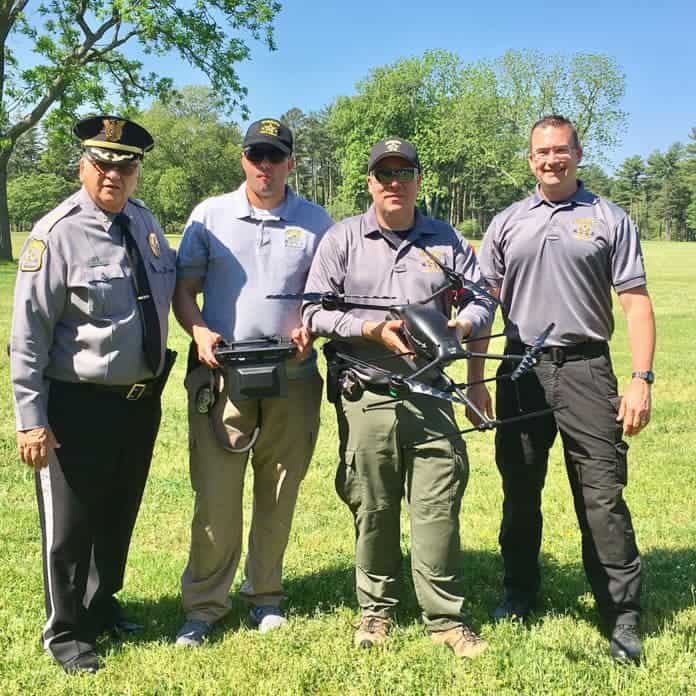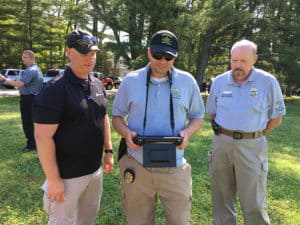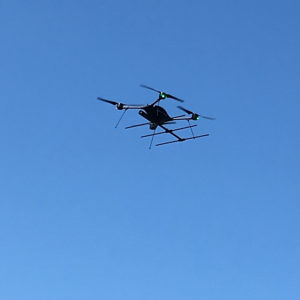
OCEAN COUNTY – The Ocean County Sheriff’s Department has a new tool in its arsenal for helping to locate missing people.
Three officers have become certified as Project Lifesaver Drone Operators that will help to find individuals who have conditions like Alzheimer’s, autism and other mental disabilities that make them prone to wandering.
At-risk individuals could be equipped with a personal transmitter worn on their ankle or wrist, and the trained officers now have the equipment to track the signal to help find the person.
Ocean County Sheriff Michael Mastronardy said that the three certified officers were chosen for their skills: Officer Carl Wydrozynski is a pilot who flies BlackHawk helicopters for the Air National Guard; Lt. Joe Green is a drone hobbyist; and Sgt. David Deleeuw, a former civil engineer and self-described “technology geek” works in the crime scene investigative unit at the Sheriff’s Department.

They had three days of training online and in a classroom where they learned the software, and then they learned how to fly the drones by performing mock missions.
The officers fly the drones up to 400 feet, but they have the ability to reach 18,000 feet, explained lead instructor Chris Gibson, who has 22 years of experience operating, teaching and selling drones through his Minneapolis, Minnesota-based company Sentera LLC.
The Project Lifesaver drone can fly in any weather and can fly twice as long as other drones, up to 50 minutes, he said.
Operators use a directional antenna that can turn on a pirouette, Gibson said. The range of the beacon is seven miles, and most “wanderers” are found within a few miles from wherever they left. The drone could also carry a camera to help locate people who are not wearing a tracking device.
“They are very easy to fly,” said helicopter pilot Wydrozynski. “This drone can do a lot of things. You can program a flight plan so it can fly by itself,” he said as he was doing a practice run at the Ocean County Police Academy on May 19.

Gibson, the instructor, agreed with him.
“For example, you could program it to do a mapping mission or document a forest fire, flood or traffic accident,” he explained. “The officer is still in control, but he can just watch while he’s doing something else.”
Ocean County has been using drones for law enforcement since 2014 and now the Sheriff’s Department has five drones and one underwater drone that all have different sets of requirements, Gibson said.
Mastronardy said that before the FAA changed the rules, drone operators needed to have a pilot’s license, even for law enforcement use.
Drones can be used by the Office of Emergency Management for before and after coastal storms, Mastronardy said.
They can also be used for search and rescue missions, traffic control, crowd control, and much more.

Project Lifesaver trainer Gary Reynolds said he travels to all 50 states to teach the technology to police officers and firefighters and how to interact with special needs people.
Reynolds, who is a police officer from Lynchburg, VA, said that there are only two police departments in the world utilizing this technology: Somerset County Sheriff’s Department, and now the Ocean County Sheriff’s Department.
“We hope that within the next year it will become a nationwide,” Reynolds said.
The cost of the Project Lifesaver drone was $48,000 and $7,500 for training. The first drone purchased by the Sheriff’s Department was paid for by the Ocean County Sheriff’s Foundation, and the others were supported by the Sheriff’s Department Budget, approved by the Board of Freeholders, said Mastronardy.






